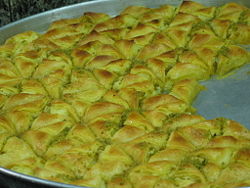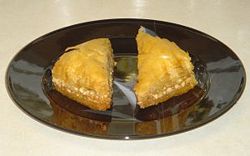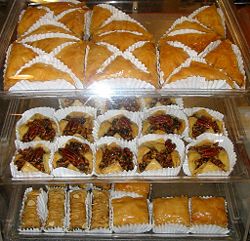Difference between revisions of "Baklava" - New World Encyclopedia
| Line 8: | Line 8: | ||
'''Baklava''' or '''baklawa''' is a rich, sweet [[pastry]] featured in many [[cuisine]]s of the former [[Ottoman Empire|Ottoman]] countries. It is a pastry made of layers of [[phyllo]] dough filled with chopped [[walnut]]s or [[pistachio]]s and sweetened with [[syrup]] or [[honey]]. | '''Baklava''' or '''baklawa''' is a rich, sweet [[pastry]] featured in many [[cuisine]]s of the former [[Ottoman Empire|Ottoman]] countries. It is a pastry made of layers of [[phyllo]] dough filled with chopped [[walnut]]s or [[pistachio]]s and sweetened with [[syrup]] or [[honey]]. | ||
| − | |||
| − | |||
==Preparation== | ==Preparation== | ||
[[Image:Baklava ST 06.JPG|thumb|left|250 px|Baklava is prepared on large trays and cut into a variety of shapes]] | [[Image:Baklava ST 06.JPG|thumb|left|250 px|Baklava is prepared on large trays and cut into a variety of shapes]] | ||
| − | + | '''Baklava''' is basically layers of crisp [[phyllo dough]] (paper-thin sheets of raw, unleavened flour dough used for making pastries) alternated with a sugary spiced [[nut]] mixture, which includes [[walnut]]s, [[almond]]s, and possibly [[pistachio]]s. Melted shortening is poured on top. After [[baking]], and the whole thing is soaked in fragrant sweet syrup made with [[honey]], [[lemon]], and [[cinnamon]]. Sweet and exotic, baklava is cut into small pieces of various shapes and cooled before serving. | |
| − | |||
| − | |||
| − | |||
| − | |||
| − | |||
| − | |||
| − | |||
| − | |||
| − | |||
| − | |||
| − | |||
== History == | == History == | ||
[[Image:Baklavas.jpg|thumb|right|200 px|Baklavas]] | [[Image:Baklavas.jpg|thumb|right|200 px|Baklavas]] | ||
| − | The word baklava entered English from [[Turkish language|Turkish]] | + | The word "baklava" entered English from [[Turkish language|Turkish]]. The history of baklava is not well-documented; but although it has been claimed by many [[ethnic group]]s, it is said to be Greek but the best evidence is that it is of [[Central Asian cuisine|Central Asian]] [[Turkic peoples|Turkic]] origin.<ref>Perry 1994, 87</ref> The thin [[phyllo dough]] as used today was probably developed in the kitchens of the [[Topkapi Palace]]. Indeed, the sultan presented trays of baklava to the [[Janissaries]] every 15th of [[Ramadan]] in a ceremonial procession called the ''Baklava Alayı''.<ref>Wasti, 2005</ref> |
| − | |||
| − | The history of baklava is not well-documented; but although it has been claimed by many ethnic | ||
| − | |||
| − | |||
| − | |||
| − | |||
[[Image:Baklava_S.jpg|thumb|right|250px|A typical baklava, sweetened with syrup.]] | [[Image:Baklava_S.jpg|thumb|right|250px|A typical baklava, sweetened with syrup.]] | ||
| − | |||
| − | + | One of the oldest known recipes for a sort of proto-baklava is found in a [[China|Chinese]] cookbook written in 1330 under the [[Yuan Dynasty|Yuan (Mongol) dynasty]] under the name ''güllach''.<ref>Paul D. Buell, "Mongol Empire and Turkicization: The Evidence of Food and Foodways," in Reuven Amitai-Preiss, and David O. Morgan (eds.), 1999</ref> "[[Güllaç]]" is found in Turkish cuisine. Layers of phyllo dough are put one by one in warmed up milk with sugar. It is served with walnut and fresh pomegranate and generally eaten during Ramadan. | |
| − | + | ==Cultural significance== | |
| + | [[Gaziantep]], a city in [[Turkey]], is famous for its baklava and, in Turkey, is widely regarded as the native city of the [[dessert]].<ref>[http://www.guide-martine.com/southeastern4.asp Guide Martin: Gaziantep]</ref> In 2008, the Turkish patent office registered a geographical indication certificate for Antep Baklava.<ref>''Newstime 7'', February 21, 2008[http://www.newstime7.com/haber/20080221/Baklava-gets-indication-certificate.php]</ref> | ||
| + | Baklava was chosen to represent [[Cyprus]] in the presentation ''Sweet Europe'' of the cultural initiative [[Café Europe]] in 2006. | ||
| − | == | + | ==Regional variations== |
[[Image:Many types of baclava.jpg|thumb|left|250 px|Several types of Baklava]] | [[Image:Many types of baclava.jpg|thumb|left|250 px|Several types of Baklava]] | ||
Baklava is the most famous of the Greek pastries, and every area of Greece - and sometimes every family within a region - has a favorite recipe. Enjoy this favorite of mine, made with walnuts and almonds, olive oil, cinnamon, and cloves. The recipe is a modified version of a Cretan specialty from Roman times, Gastrin. | Baklava is the most famous of the Greek pastries, and every area of Greece - and sometimes every family within a region - has a favorite recipe. Enjoy this favorite of mine, made with walnuts and almonds, olive oil, cinnamon, and cloves. The recipe is a modified version of a Cretan specialty from Roman times, Gastrin. | ||
| Line 58: | Line 40: | ||
==References== | ==References== | ||
| − | * Amitai-Preiss | + | * Reuven Amitai-Preiss and David O. Morgan, eds., ''The Mongol Empire and Its Legacy'' Brill, 1999. ISBN 9004119469 |
| + | * Paul D. Buell, "Mongol Empire and Turkicization: The Evidence of Food and Foodways," p. 200''ff'', in Amitai-Preiss, ''op.cit.'' | ||
* Christian, David. Review of Amitai-Preiss, ''op.cit.'', in ''Journal of World History'' '''12''':2:476 (2001). | * Christian, David. Review of Amitai-Preiss, ''op.cit.'', in ''Journal of World History'' '''12''':2:476 (2001). | ||
* Perry, Charles. "The Taste for Layered Bread among the Nomadic Turks and the Central Asian Origins of Baklava," in ''A Taste of Thyme: Culinary Cultures of the Middle East'' (ed. Sami Zubaida, Richard Tapper), 1994. ISBN 1-86064-603-4. | * Perry, Charles. "The Taste for Layered Bread among the Nomadic Turks and the Central Asian Origins of Baklava," in ''A Taste of Thyme: Culinary Cultures of the Middle East'' (ed. Sami Zubaida, Richard Tapper), 1994. ISBN 1-86064-603-4. | ||
| − | * Roden | + | * Claudia, Roden. ''The New Book of Middle Eastern Food''. Knopf, 2000. ISBN 978-0375405068 |
* Vryonis, Speros, ''The Decline of Medieval Hellenism in Asia Minor'', 1971. Quoted in Perry (1994). | * Vryonis, Speros, ''The Decline of Medieval Hellenism in Asia Minor'', 1971. Quoted in Perry (1994). | ||
* Wasti, Syed Tanvir, "The Ottoman Ceremony of the Royal Purse," ''Middle Eastern Studies'' '''41''':2:193–200 (March 2005) | * Wasti, Syed Tanvir, "The Ottoman Ceremony of the Royal Purse," ''Middle Eastern Studies'' '''41''':2:193–200 (March 2005) | ||
Revision as of 14:31, 20 June 2008
Baklava or baklawa is a rich, sweet pastry featured in many cuisines of the former Ottoman countries. It is a pastry made of layers of phyllo dough filled with chopped walnuts or pistachios and sweetened with syrup or honey.
Preparation
Baklava is basically layers of crisp phyllo dough (paper-thin sheets of raw, unleavened flour dough used for making pastries) alternated with a sugary spiced nut mixture, which includes walnuts, almonds, and possibly pistachios. Melted shortening is poured on top. After baking, and the whole thing is soaked in fragrant sweet syrup made with honey, lemon, and cinnamon. Sweet and exotic, baklava is cut into small pieces of various shapes and cooled before serving.
History
The word "baklava" entered English from Turkish. The history of baklava is not well-documented; but although it has been claimed by many ethnic groups, it is said to be Greek but the best evidence is that it is of Central Asian Turkic origin.[1] The thin phyllo dough as used today was probably developed in the kitchens of the Topkapi Palace. Indeed, the sultan presented trays of baklava to the Janissaries every 15th of Ramadan in a ceremonial procession called the Baklava Alayı.[2]
One of the oldest known recipes for a sort of proto-baklava is found in a Chinese cookbook written in 1330 under the Yuan (Mongol) dynasty under the name güllach.[3] "Güllaç" is found in Turkish cuisine. Layers of phyllo dough are put one by one in warmed up milk with sugar. It is served with walnut and fresh pomegranate and generally eaten during Ramadan.
Cultural significance
Gaziantep, a city in Turkey, is famous for its baklava and, in Turkey, is widely regarded as the native city of the dessert.[4] In 2008, the Turkish patent office registered a geographical indication certificate for Antep Baklava.[5]
Baklava was chosen to represent Cyprus in the presentation Sweet Europe of the cultural initiative Café Europe in 2006.
Regional variations
Baklava is the most famous of the Greek pastries, and every area of Greece - and sometimes every family within a region - has a favorite recipe. Enjoy this favorite of mine, made with walnuts and almonds, olive oil, cinnamon, and cloves. The recipe is a modified version of a Cretan specialty from Roman times, Gastrin.
In Greek: γάστριν, pronounced GHAHS-treen
Sesame seeds, pepper, and poppy seeds are only some of the unusual ingredients in this ancient recipe. Petimezi (a sweetener made from grapes), used long before sugar arrived in Greece, adds to the unique taste. If you're hooked on the Ancients, give this recipe a try.
Balkava (from the Farsi for "many leaves"), a pastry perfected by royal bakers in the sultan's palace in Istanbul, consists of layers of phyllo filled with nuts and spices and drenched in a syrup. It has become a traditional Middle Eastern Rosh Hashannah and Purim treat but is enjoyed at celebrations throughout the year. There are numerous variations of baklava, many a closely guarded secret passed down within families. A walnut filling is more prevalent in the Levant, while pistachios and pistachio-almond fillings are preferred in Iran. Blanched almonds are traditional on Rosh Hashannah to produce a light color so that the year should be dulce y aclarada ("sweet and bright"). Sephardim refrain from serving dark-colored pastries such as those made from walnuts on Rosh Hashannah, which would portend a dark year. Although purists disdain anything except the classic nut filling, some cooks innovated by adding such items as dates and chocolate chips. Hungarians make an apricot version. This very rich treat is usually served in small portions.[6]
Notes
- ↑ Perry 1994, 87
- ↑ Wasti, 2005
- ↑ Paul D. Buell, "Mongol Empire and Turkicization: The Evidence of Food and Foodways," in Reuven Amitai-Preiss, and David O. Morgan (eds.), 1999
- ↑ Guide Martin: Gaziantep
- ↑ Newstime 7, February 21, 2008[1]
- ↑ Gil Marks, middle eastern nut-filled multilayered pastry (baklava) The World Of Jewish Desserts (Simon & Schuster, 2000, ISBN 978-0684870038) Epicurious.com Retrieved June 18, 2008.
ReferencesISBN links support NWE through referral fees
- Reuven Amitai-Preiss and David O. Morgan, eds., The Mongol Empire and Its Legacy Brill, 1999. ISBN 9004119469
- Paul D. Buell, "Mongol Empire and Turkicization: The Evidence of Food and Foodways," p. 200ff, in Amitai-Preiss, op.cit.
- Christian, David. Review of Amitai-Preiss, op.cit., in Journal of World History 12:2:476 (2001).
- Perry, Charles. "The Taste for Layered Bread among the Nomadic Turks and the Central Asian Origins of Baklava," in A Taste of Thyme: Culinary Cultures of the Middle East (ed. Sami Zubaida, Richard Tapper), 1994. ISBN 1-86064-603-4.
- Claudia, Roden. The New Book of Middle Eastern Food. Knopf, 2000. ISBN 978-0375405068
- Vryonis, Speros, The Decline of Medieval Hellenism in Asia Minor, 1971. Quoted in Perry (1994).
- Wasti, Syed Tanvir, "The Ottoman Ceremony of the Royal Purse," Middle Eastern Studies 41:2:193–200 (March 2005)
- Gaifyllia, Nancy. The Art of Baklava About.com. Retrieved June 18, 2008.
- Mark, Gil. The World Of Jewish Desserts. Simon & Schuster, 2000. ISBN 978-0684870038
External links
Credits
New World Encyclopedia writers and editors rewrote and completed the Wikipedia article in accordance with New World Encyclopedia standards. This article abides by terms of the Creative Commons CC-by-sa 3.0 License (CC-by-sa), which may be used and disseminated with proper attribution. Credit is due under the terms of this license that can reference both the New World Encyclopedia contributors and the selfless volunteer contributors of the Wikimedia Foundation. To cite this article click here for a list of acceptable citing formats.The history of earlier contributions by wikipedians is accessible to researchers here:
The history of this article since it was imported to New World Encyclopedia:
Note: Some restrictions may apply to use of individual images which are separately licensed.




